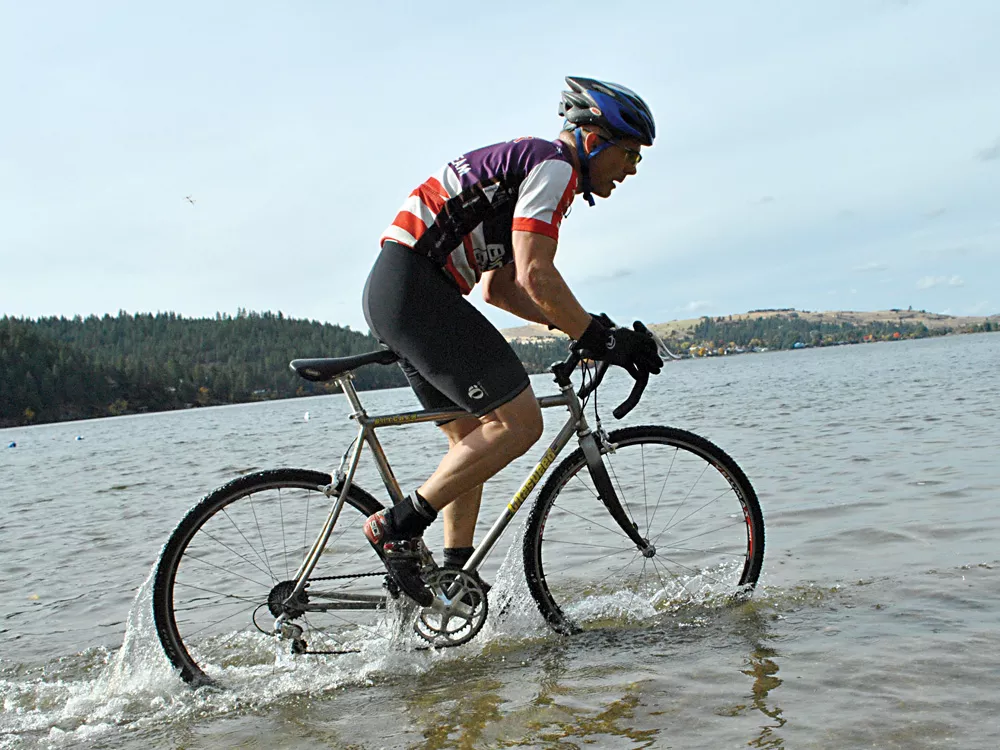Remembering the trench warfare he had witnessed in World War I, German author Erich Maria Remarque wrote in All Quiet on the Western Front about the ravages of war on soldiers’ psyches: “We are insensible, dead men, who through some trick, some dreadful magic, are still able to run and to kill.”
A similar transformation occurs in cyclocross racing, an increasingly popular variant of bicycle racing that is one part velodrome and about six parts lung-busting, quad-burning boot-camp obstacle course.
“It’s pretty painful,” says Jason Oestreicher, a dreadlocked tattoo artist who showed up and won the mountain bike category of a race at Liberty Lake last month. He measured the pain the old-fashioned way. “On a scale of one to 10, I’m probably about an 8 1/2.”
In cyclocross, riders on beefed-up road bikes (and a separate category of mountain bikers) race around short circuits of mixed terrain, from grass to sand to gravel, negotiating manmade obstacles along the way. The sport, traditionally contested in late fall, is known for pushing riders through snow and mud and rain. So far, though, this year’s Inland Northwest Cyclocross Series, a season of races that happen all over Eastern Washington through October and November, has been relatively mild.
Still, that doesn’t mean it’s been easy: Success in cyclocross is predicated on pain and your ability to tolerate it. In that way, it’s similar to most forms of bike racing.
Where it diverges is in length: Cyclocross races last, on the long end, a scant 55 minutes. On the low end, they’re 30 minutes. If you’re doing it right, you should be doing one thing, regardless of the duration: suffering.
“The intensity definitely shocked me,” Oestreicher says. “Halfway through the first lap, I was gasping.”
That intensity comes, in part, from the barriers, wooden two-by-fours stacked one on top of the other. Racers can’t ride over or around the barriers, so they have to — quickly, in fluid motions — dismount and leap over the barriers with their bikes on their shoulders, then jump back on.
Some racers gracefully dismount and hop over the barriers. Others cramp up after dismounting, or catch their shorts on their seats and bring their bike and their shorts down. The agony comes from the shift between pedaling frantically, running, and then jumping through the air.
There are other forms of hurt as well. At a race last
weekend in Moses Lake, Wash., riders had to descend a sweeping
180-degree turn down a sandy hillside. Some negotiated it smoothly.
Others crashed into each other, and an uncoordinated few ended up riding
their face down the sandy slope.
Theo Propst had a few tricks up his sleeve when he designed the cyclocross course at Liberty Lake. One portion of the course, called “the spiral of death,” or “the toilet bowl,” has riders snaking around in endless 180-degree turns over the grass. In the crowded first lap of a recent race, when riders were still clumped together, several collided and ended up in tangled heaps.
“Variety is the spice of cyclocross,” Propst says. “Every course is different.”
This one being in Liberty Lake, Propst opted to drag racers through the lake, or at least part of it; riders, at one point, rode down the beach, into the water for a few feet, then up the sandy shore and back onto the course.
“I decided to use the whole park,” says Propst, who is organizing the race for the fourth year. The beach’s sand sucks up the tire’s traction, Propst says, but “you can rail it once you get through the sand.”
Legend has it that cyclocross started in France around the beginning of the 20th century, after a soldier bragged about riding his road bike on rutted farm roads in the winter to maintain fitness. Nowadays, there are national and world championships for the sport and races all over the Inland Northwest.
The local series has been attended by University of Idaho students, newlywed ski bums from Columbia County, farm owners from Walla Walla.
Mark Knokey has shown up at every race so far this season and won his category, Masters 40 to 49. Though a dedicated road bicyclist, he prefers cyclocross.
“It’s just a more family atmosphere,” he says, gesturing to a host of children conquering a playground on the lake’s shoreline.
Across the grassy field, riders were streaming in at the finish line of one of the last races of the day.
“Did you race? How was it?” asked a spectator to a haggard competitor who had just finished.
“Miserable,” the racer replied, and they both laughed.

